DESCRIPTION
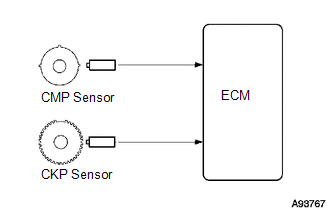 When
the engine misfires, high concentrations of hydrocarbons (HC) enter the
exhaust gas. Extremely high HC concentration levels can cause increases
in exhaust emission levels. High concentrations of HC can also cause
increases in the Three-Way Catalytic Converter (TWC) temperature, which
may cause damage to the TWC. To prevent these increases in emissions and
to limit the possibility of thermal damage, the ECM monitors the
misfire rate. When the temperature of the TWC reaches the point of
thermal degradation, the MIL blinks. To monitor misfires, the ECM uses
both the Camshaft Position (CMP) sensor and the Crankshaft Position
(CKP) sensor. The CMP sensor is used to identify any misfiring cylinders
and the CKP sensor is used to measure variations in the crankshaft
rotation speed. Misfires are counted as when the crankshaft rotation
speed variations exceed predetermined thresholds. If the misfire rate exceeds the threshold level, the ECM illuminates the MIL and stores a DTC. |
DTC No. | DTC Detection Condition |
Trouble Area | | P0300 |
Simultaneous misfiring of several cylinders occurs and one of following conditions below is detected (2 trip detection logic):
- High temperature misfire occurs in Three-Way Catalytic Converter (TWC) (MIL blinks when detect immediately).
- Emission deterioration misfire occurs (MIL illuminates).
|
- Open or short in engine wire harness
- Connector connection
- Vacuum hose connections
- Ignition system
- Injector assembly
- Fuel pressure
- Mass Air Flow (MAF) meter
- Engine Coolant Temperature (ECT) sensor
- Compression pressure
- Valve timing
- PCV valve and hose
- PCV hose connections
- Air induction system
- EGR valve assembly
- ECM
| | P0301
P0302 P0303 P0304 P0305 P0306 P0307
P0308 | Misfiring of specific cylinder occurs and one of following conditions below is detected (2 trip detection logic):
- High temperature misfire occurs in Three-Way Catalytic Converter (TWC) (MIL blinks when detect immediately).
- Emission deterioration misfire occurs (MIL illuminates).
| When
multiple DTCs for misfiring cylinders are stored, but DTC P0300 is not
stored, it indicates that misfires have been detected in different
cylinders at different times. DTC P0300 is only stored when several
misfiring cylinders are detected at the same time. MONITOR DESCRIPTION
The
ECM illuminates the MIL and stores a DTC when either one of the
following conditions, which could cause emission deterioration, is
detected (2 trip detection logic).
- Within the first 1000 crankshaft revolutions of the engine starting, an
excessive misfiring rate (approximately 10 to 50 misfires per 1000
crankshaft revolutions) occurs once.
- An excessive misfiring rate (approximately 10 to 50 misfires per 1000 crankshaft revolutions) occurs a total of 4 times.
The ECM flashes the MIL
(immediate detection logic) and stores a DTC (2 trip detection logic)
when either one of the following conditions, which could cause Three-Way
Catalytic Converter (TWC) damage, is detected (2 trip detection logic).
- At a high engine rpm, a sufficient amount of misfires to damage the
catalyst occurring within 200 crankshaft revolutions is detected once.
- At a normal engine rpm, a sufficient amount of misfires to damage the
catalyst occurring within 200 crankshaft revolutions is detected 3
times.
HINT: If a catalyst damage misfire occurs, the ECM informs the driver by flashing the MIL. MONITOR STRATEGY |
Related DTCs | P0300: Multiple cylinder misfire
P0301: Cylinder 1 misfire P0302: Cylinder 2 misfire P0303: Cylinder 3 misfire
P0304: Cylinder 4 misfire P0305: Cylinder 5 misfire P0306: Cylinder 6 misfire
P0307: Cylinder 7 misfire P0308: Cylinder 8 misfire | |
Required Sensors/Components (Main) | Crankshaft position sensor and camshaft position sensor | |
Required Sensors/Components (Related) |
Engine coolant temperature and intake air temperature sensors and mass air flow meter | |
Frequency of Operation | Continuous | |
Duration | 1000 crankshaft revolutions (soon after engine is started: 1 time, other 4 times) (Emissions-related misfire)
200 crankshaft revolutions (1 or 3 times) (Catalyst-damaging misfire) | |
MIL Operation | 2 driving cycles: MIL illuminates when misfire detected
MIL flashes immediately: When catalyst damaged misfire occurs | |
Sequence of Operation | None | TYPICAL ENABLING CONDITIONS Misfire |
Monitor runs whenever following DTCs not present |
P0016, P0018 (VVT system - Misalignment) P0017, P0019 (Exhaust VVT system - Misalignment)
P0102, P0103 (Mass air flow meter) P0107, P0108 (Manifold absolute pressure)
P0112, P0113 (Intake air temperature sensor) P0115, P0117, P0118 (Engine coolant temperature sensor)
P0120, P0121, P0122, P0123, P0220, P0222, P0223, P2135 (Throttle position sensor)
P0125 (Insufficient Coolant Temperature for Closed Loop Fuel Control)
P0327, P0328, P032C, P032D, P0332, P0333, P033C, P033D (Knock Sensor)
P0335 (Crankshaft position sensor) P1340 (Camshaft position sensor)
P0351 - P0358 (Igniter) P0500 (Vehicle speed sensor) | |
Battery voltage | 8 V or more | |
VVT system | Not operated by scan tool | |
Engine RPM | 400 to 5900 rpm | |
Either of following conditions (a) or (b) met |
- | | (a) ECT at engine start |
More than -7°C (19°F) | | (b) ECT |
More than 20°C (68°F) | | Fuel cut |
OFF | Monitor Period of Emission-Related-Misfire |
First 1000 revolutions after engine start, or Check Mode |
Crankshaft 1000 revolutions | | Except above |
Crankshaft 1000 revolutions x 4 | Monitor Period of Catalyst-Damaged-Misfire (MIL Blinks) |
All of following conditions 1, 2, 3 and 4 met |
Crankshaft 200 revolutions x 3 | |
Except above (MIL blinks immediately) |
Crankshaft 200 revolutions | |
1. Driving cycles | 1st | |
2. Check mode | OFF | |
3. Engine RPM | Less than 2200 rpm | |
4. Engine load | Less than 70% | TYPICAL MALFUNCTION THRESHOLDS Monitor Period of Emission-Related-Misfire |
Misfire rate | 1.5% or more | Monitor Period of Catalyst-Damaged-Misfire (MIL Blinks) |
Number of misfires per 200 revolutions | 144 or more (varies with intake air amount and RPM) | MONITOR RESULT
Refer to Checking Monitor Status (See page  ). ). WIRING DIAGRAM
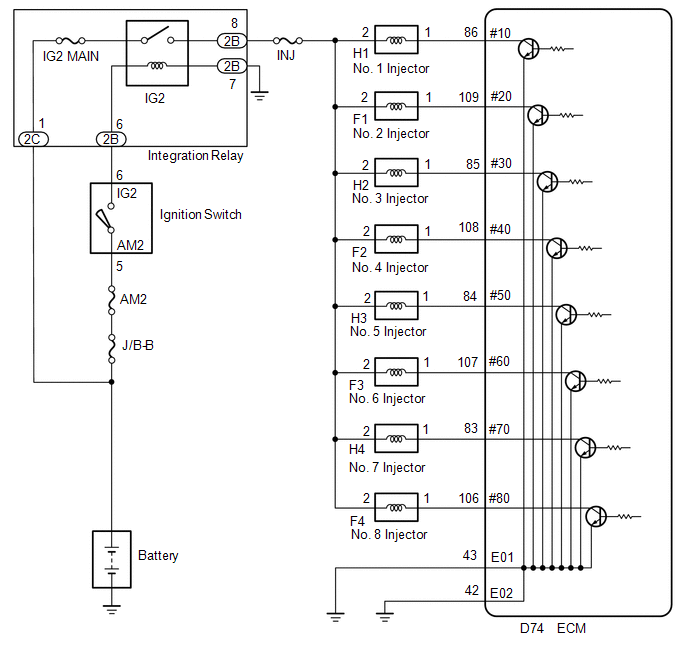
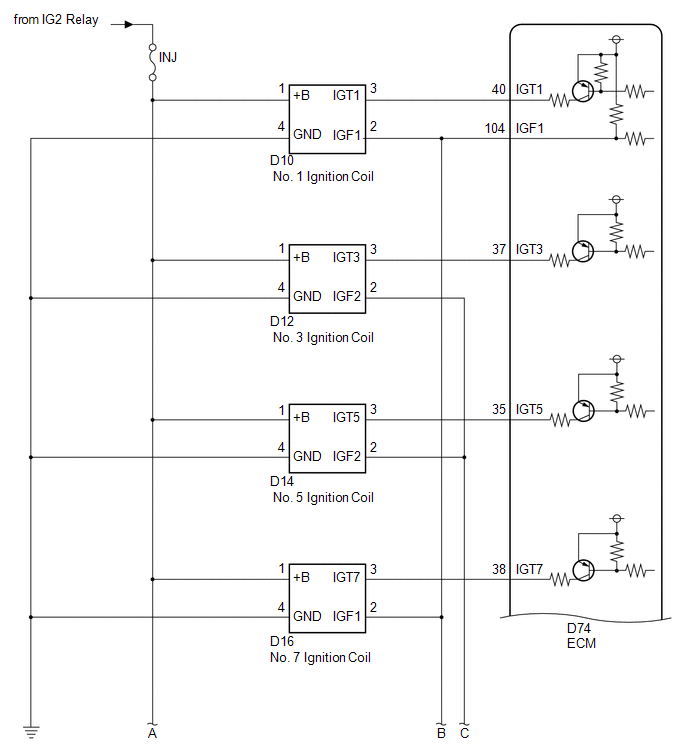
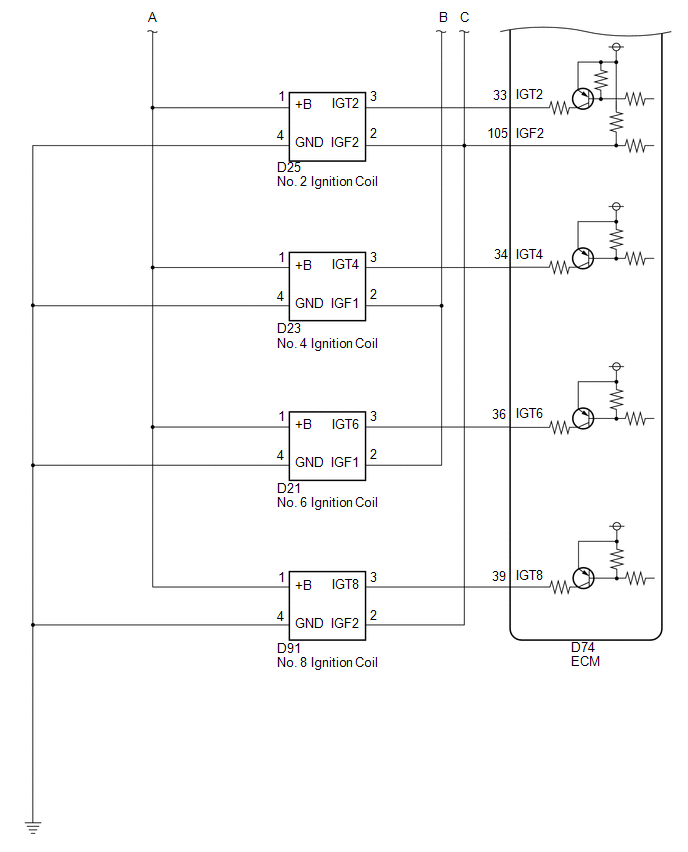 CONFIRMATION DRIVING PATTERN
- Connect the Techstream to the DLC3.
- Turn the ignition switch to ON.
- Turn the Techstream on.
- Record the DTC(s) and freeze frame data.
- Clear DTCs (even if no DTCs are stored, perform the clear DTC operation).
- Using the Techstream, switch the ECM from normal mode to check mode (See page
 ). ).
- Read the misfire counts of each cylinder (cylinder No. 1 to No. 8) with
the engine idling. If any misfire count is displayed, skip the following
confirmation driving pattern.
- Drive the vehicle several times with the conditions, such as engine rpm
and engine load, as shown in Misfire RPM and Misfire Load in the freeze
frame data.
HINT:
In order to
store misfire DTCs, it is necessary to operate the vehicle for the
period of time shown in the table below, with the engine speed and
engine load the same as Misfire RPM and Misfire Load in the freeze frame
data.
|
Engine RPM |
Duration |
|
Idling |
8.0 minutes or more |
|
1000 |
4.5 minutes or more |
|
2000 |
2.5 minutes or more |
|
3000 |
1.5 minutes or more |
- Check whether misfires have occurred by checking DTCs and freeze frame data.
HINT:
Do
not turn the ignition switch off until the stored DTC(s) and freeze
frame data have been recorded. When the ECM returns to normal mode
(default), the stored DTC(s), freeze frame data and other data will be
cleared.
- Record the DTC(s), freeze frame data and misfire counts.
- Turn the ignition switch off and wait for at least 5 seconds.
- Clear DTCs (even if no DTCs are stored, perform the clear DTC operation).
CAUTION / NOTICE / HINT
HINT:
PROCEDURE |
1. | CHECK ANY OTHER DTCS OUTPUT (IN ADDITION TO MISFIRE CODES) |
(a) Connect the Techstream to the DLC3. (b) Turn the ignition switch to ON.
(c) Turn the Techstream on. (d) Enter the following menus: Powertrain / Engine and ECT / Trouble Codes.
(e) Read DTCs. Result |
Result | Proceed to | |
P0300, P0301, P0302, P0303, P0304, P0305, P0306, P0307 and/or P0308 is output |
A | | P0300, P0301, P0302, P0303, P0304, P0305, P0306, P0307 and/or P0308 and other DTCs are output |
B | HINT: If
any DTCs other than P0300, P0301, P0302, P0303, P0304, P0305, P0306,
P0307 and P0308 are output, troubleshoot those DTCs first.
| B |
 | GO TO DTC CHART |
|
A |
 | |
| 2. |
CHECK PCV HOSE CONNECTIONS | (a) Check the PCV hose connections.
OK: PCV hose is connected correctly and is not damaged.
| NG |
 | REPAIR OR REPLACE PCV HOSE |
|
OK |
 | |
| 3. |
READ VALUE USING TECHSTREAM (MISFIRE RPM AND MISFIRE LOAD) |
(a) Connect the Techstream to the DLC3. (b) Turn the ignition switch to ON.
(c) Turn the Techstream on. (d) Enter the following menus: Powertrain / Engine and ECT / Data List / Misfire RPM and Misfire Load.
(e) Read and note the Misfire RPM and Misfire Load values. HINT:
The Misfire RPM and Misfire Load values indicate the vehicle conditions under which the misfire occurred.
|
NEXT |
 | |
| 4. |
READ VALUE USING TECHSTREAM | (a) Connect the Techstream to the DLC3.
(b) Turn the ignition switch to ON. (c) Turn the Techstream on.
(d) Enter the following menus: Powertrain / Engine and ECT / Data List / Catalyst OT MF F/C.
(e) Read the value displayed on the Techstream. Result |
Data List | Techstream Display |
Proceed to | |
Catalyst OT MF F/C | AVAIL (Avail) |
A | | NOT AVL (Not Avl) |
B |
| B |
 | GO TO STEP 6 |
|
A |
 | |
| 5. |
PERFORM ACTIVE TEST USING TECHSTREAM | (a) Connect the Techstream to the DLC3.
(b) Turn the ignition switch to ON. (c) Turn the Techstream on.
(d) Clear DTCs (See page  ). ). (e) Enter the following menus: Powertrain / Engine and ECT / Active Test / Prohibit the Catalyst OT Misfire prevent F/C.
(f) Perform the Active Test. NOTICE: When performing the Active Test, make sure the vehicle is stopped and either idling or being revved within 3000 rpm.
|
NEXT |
 | |
| 6. |
READ VALUE USING TECHSTREAM (MISFIRE COUNT) |
(a) Enter the following menus: Powertrain / Engine and ECT / Data List / Cylinder #1 Misfire Count to Cylinder #8 Misfire Count.
(b) Allow the engine to idle. (c)
Read each value for Cylinder #1 Misfire Count to Cylinder #8 Misfire
Count displayed on the Techstream. If no misfire counts occur in any
cylinders, perform the following procedures: (1) Move the shift lever to D.
(2) Check Cylinder #1 Misfire Count to Cylinder #8 Misfire Count. (3) If misfire counts are still not displayed, perform procedure "A" and "B", and then check the misfire counts again.
Procedure
A: Drive the vehicle with the Misfire RPM and Misfire Load noted in the
"Read value using Techstream (Misfire RPM and Misfire Load)" procedures
above. Procedure B: Read Cylinder #1 Misfire Count to Cylinder #8 Misfire Count or DTCs displayed on the Techstream. Result |
Result | Proceed to | |
Most misfires occur in only 1 or 2 cylinders |
A | | 3 cylinders or more have equal misfire counts |
B |
HINT:
- If it is difficult to reproduce misfires for each cylinder, check the
Data List item called Misfire Margin. Try to find vehicle driving
conditions that lower the Misfire Margin value. Values above 30% are
considered normal.
- If the freeze frame data's record of the ECT is below 75°C (167°F), the misfire may be detected only when the engine is cold.
- If the freeze frame data's record of the Engine Run Time is below 120
seconds, the misfire may be detected immediately after the engine is
started.
| B |
 | GO TO STEP 19 |
|
A |
 | |
(a) Inspect the spark plug of the misfiring cylinder (See page
 ). ). HINT: Perform "Inspection After Repair" after replacing the spark plug (See page
 ). ).
| NG |  |
REPLACE SPARK PLUG |
|
OK |
 | |
| 8. |
CHECK FOR SPARK (SPARK TEST) | (a) Perform the spark test (See page
 ). ).
HINT:
- If the result of the spark test is normal, proceed to the next step.
- Perform "Inspection After Repair" after replacing the ignition coil or the spark plug (See page
 ). ).
|
NEXT |
 | |
| 9. |
CHECK CYLINDER COMPRESSION PRESSURE | (a) Measure the cylinder compression pressure of the misfiring cylinder (See page
 ). ). HINT: Perform "Inspection After Repair" after repairing or replacing the engine assembly (See page
 ). ).
| NG |  |
CHECK ENGINE TO DETERMINE CAUSE OF LOW COMPRESSION |
|
OK |
 | |
| 10. |
INSPECT ECM TERMINAL OF MISFIRING CYLINDER |
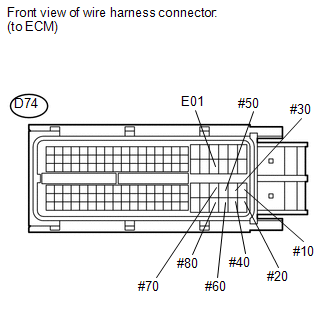 (a) Disconnect the ECM connector.
(b) Turn the ignition switch to ON. (c) Measure the voltage according to the value(s) in the table below.
Standard Voltage: |
Tester Connection | Switch Condition |
Specified Condition | |
D74-86 (#10) - D74-43 (E01) |
Ignition switch ON | 11 to 14 V | |
D74-109 (#20) - D74-43 (E01) |
Ignition switch ON | 11 to 14 V | |
D74-85 (#30) - D74-43 (E01) |
Ignition switch ON | 11 to 14 V | |
D74-108 (#40) - D74-43 (E01) |
Ignition switch ON | 11 to 14 V | |
D74-84 (#50) - D74-43 (E01) |
Ignition switch ON | 11 to 14 V | |
D74-107 (#60) - D74-43 (E01) |
Ignition switch ON | 11 to 14 V | |
D74-83 (#70) - D74-43 (E01) |
Ignition switch ON | 11 to 14 V | |
D74-106 (#80) - D74-43 (E01) |
Ignition switch ON | 11 to 14 V |
| NG |
 | GO TO FUEL INJECTOR CIRCUIT |
|
OK |
 | |
| 11. |
CHECK FUEL INJECTOR OF MISFIRING CYLINDER |
(a) Check the injector injection [whether fuel volume is high or low, and whether injection pattern is poor] (See page
 ). ). HINT: Perform "Inspection After Repair" after replacing the fuel injector assembly (See page
 ). ).
| NG |  |
REPLACE FUEL INJECTOR ASSEMBLY |
|
OK |
 | |
(a) Check the intake system for vacuum leakage (See page
 ). ). OK: No leakage in intake system.
HINT: Perform "Inspection After Repair" after repairing or replacing the intake system (See page
 ). ).
| NG |  |
REPAIR OR REPLACE INTAKE SYSTEM |
|
OK |
 | |
(a) Check the fuel pressure (See page
 ). ).
| NG |  |
GO TO STEP 36 |
|
OK |
 | |
| 14. |
READ VALUE USING TECHSTREAM (COOLANT TEMP) |

| NG |  |
REPLACE ENGINE COOLANT TEMPERATURE SENSOR |
|
OK |
 | |
| 15. |
READ VALUE USING TECHSTREAM (MAF) | (a) Connect the Techstream to the DLC3.
(b) Turn the ignition switch to ON. (c) Turn the Techstream on.
(d) Enter the following menus: Powertrain / Engine and ECT / Data List / MAF and Coolant Temp.
(e) Allow the engine to idle until Coolant Temp reaches 75°C (167°F) or higher.
(f) Read the MAF with the engine speed at 3000 rpm. Standard: Between 18.3 gm/sec. and 25.8 gm/sec. (shift lever: N; A/C: Off)
| NG |
 | GO TO STEP 31 |
|
OK |
 | |

| NG |  |
ADJUST VALVE TIMING |
|
OK |
 | |
| 17. |
PERFORM ACTIVE TEST USING TECHSTREAM (CONTROL THE EGR STEP POSITION) |
(a) Connect the Techstream to the DLC3. (b) Start the engine and warm it up until the engine coolant temperature reaches 75°C (167°F) or higher.
HINT:
- When performing the Active Test, make sure the shift lever is in P or N.
- The A/C switch and all accessory switches should be off.
(c) Turn the Techstream on. (d) Enter the following menus: Powertrain / Engine and ECT / Active Test / Control the EGR Step Position.
(e)
Confirm the Throttle Idle Position is ON and check the engine idling
condition and MAP values in the Data List while performing the Active
Test.
HINT:
- Do not leave the EGR valve open for 10 seconds or more during the Active Test.
- Be sure to return the EGR valve to step 0 when the Active Test is completed.
OK: MAP and idling condition change in response to EGR step position as follows.
Standard: |
- | EGR Step Position (Active Test) | |
0 Steps | 0 to 30 Steps | |
Idling condition | Steady idling |
Idling changes from steady to rough idling or engine stall | |
MAP (Data List) |
20 to 40 kPa (150 to 300 mmHg) |
MAP value is at least +10 kPa (75 mmHg) higher than when EGR valve is fully closed |
| OK |
 | GO TO STEP 31 |
|
NG |
 | |
| 18. |
INSPECT EGR VALVE ASSEMBLY | (a) Remove the EGR valve assembly (See page
 ). ). (b) Check if the EGR valve is stuck open.
OK: EGR valve is tightly closed. HINT: Perform "Inspection After Repair" after replacing the EGR valve assembly (See page
 ). ).
| OK |  |
GO TO STEP 31 |
| NG |
 | REPLACE EGR VALVE ASSEMBLY |
(a) Check the intake system for vacuum leakage (See page
 ). ). OK: No leakage in intake system.
HINT: Perform "Inspection After Repair" after repairing or replacing the intake system (See page
 ). ).
| NG |  |
REPAIR OR REPLACE INTAKE SYSTEM |
|
OK |
 | |
(a) Check the fuel pressure (See page
 ). ).
| NG |  |
GO TO STEP 36 |
|
OK |
 | |
| 21. |
READ VALUE USING TECHSTREAM (COOLANT TEMP) |

| NG |  |
REPLACE ENGINE COOLANT TEMPERATURE SENSOR |
|
OK |
 | |
| 22. |
READ VALUE USING TECHSTREAM (MAF) | (a) Connect the Techstream to the DLC3.
(b) Turn the ignition switch to ON. (c) Turn the Techstream on.
(d) Enter the following menus: Powertrain / Engine and ECT / Data List / MAF and Coolant Temp.
(e) Allow the engine to idle until Coolant Temp reaches 75°C (167°F) or higher.
(f) Read the MAF with the engine speed at 3000 rpm. Standard: Between 18.3 gm/sec. and 25.8 gm/sec. (shift lever: N; A/C: Off)
| NG |
 | GO TO STEP 31 |
|
OK |
 | |

| NG |  |
ADJUST VALVE TIMING |
|
OK |
 | |
| 24. |
PERFORM ACTIVE TEST USING TECHSTREAM (CONTROL THE EGR STEP POSITION) |
(a) Connect the Techstream to the DLC3. (b) Start the engine and warm it up until the engine coolant temperature reaches 75°C (167°F) or higher.
HINT:
- When performing the Active Test, make sure the shift lever is in P or N.
- The A/C switch and all accessory switches should be off.
(c) Turn the Techstream on. (d) Enter the following menus: Powertrain / Engine and ECT / Active Test / Control the EGR Step Position.
(e)
Confirm the Throttle Idle Position is ON and check the engine idling
condition and MAP values in the Data List while performing the Active
Test.
HINT:
- Do not leave the EGR valve open for 10 seconds or more during the Active Test.
- Be sure to return the EGR valve to step 0 when the Active Test is completed.
OK: MAP and idling condition change in response to EGR step position as follows.
Standard: |
- | EGR Step Position (Active Test) | |
0 Steps | 0 to 30 Steps | |
Idling condition | Steady idling |
Idling changes from steady to rough idling or engine stall | |
MAP (Data List) |
20 to 40 kPa (150 to 300 mmHg) |
MAP value is at least +10 kPa (75 mmHg) higher than when EGR valve is fully closed |
| OK |
 | GO TO STEP 31 |
|
NG |
 | |
| 25. |
INSPECT EGR VALVE ASSEMBLY | (a) Remove the EGR valve assembly (See page
 ). ). (b) Check if the EGR valve is stuck open.
OK: EGR valve is tightly closed. HINT: Perform "Inspection After Repair" after replacing the EGR valve assembly (See page
 ). ).
| NG |  |
REPLACE EGR VALVE ASSEMBLY |
|
OK |
 | |
(a) Inspect the spark plug of the misfiring cylinder (See page
 ). ). HINT: Perform "Inspection After Repair" after replacing the spark plug (See page
 ). ).
| NG |  |
REPLACE SPARK PLUG |
|
OK |
 | |
| 27. |
CHECK FOR SPARK (SPARK TEST) | (a) Perform the spark test (See page
 ). ).
HINT:
- If the result of the spark test is normal, proceed to the next step.
- Perform "Inspection After Repair" after replacing the ignition coil or the spark plug (See page
 ). ).
|
NEXT |
 | |
| 28. |
CHECK CYLINDER COMPRESSION PRESSURE | (a) Measure the cylinder compression pressure of the misfiring cylinder (See page
 ). ). HINT: Perform "Inspection After Repair" after repairing or replacing the engine assembly (See page
 ). ).
| NG |  |
CHECK ENGINE TO DETERMINE CAUSE OF LOW COMPRESSION |
|
OK |
 | |
| 29. |
INSPECT ECM TERMINAL OF MISFIRING CYLINDER (#10, #20, #30, #40, #50, #60, #70 AND/OR #80 VOLTAGE) |
 (a) Disconnect the ECM connector.
(b) Turn the ignition switch to ON. (c) Measure the voltage according to the value(s) in the table below.
Standard Voltage: |
Tester Connection | Switch Condition |
Specified Condition | |
D74-86 (#10) - D74-43 (E01) |
Ignition switch ON | 11 to 14 V | |
D74-109 (#20) - D74-43 (E01) |
Ignition switch ON | 11 to 14 V | |
D74-85 (#30) - D74-43 (E01) |
Ignition switch ON | 11 to 14 V | |
D74-108 (#40) - D74-43 (E01) |
Ignition switch ON | 11 to 14 V | |
D74-84 (#50) - D74-43 (E01) |
Ignition switch ON | 11 to 14 V | |
D74-107 (#60) - D74-43 (E01) |
Ignition switch ON | 11 to 14 V | |
D74-83 (#70) - D74-43 (E01) |
Ignition switch ON | 11 to 14 V | |
D74-106 (#80) - D74-43 (E01) |
Ignition switch ON | 11 to 14 V |
| NG |
 | GO TO FUEL INJECTOR CIRCUIT |
|
OK |
 | |
| 30. |
CHECK FUEL INJECTOR OF MISFIRING CYLINDER |
(a) Check the injector injection [whether fuel volume is high or low, and whether injection pattern is poor] (See page
 ). ). HINT: Perform "Inspection After Repair" after replacing the fuel injector assembly (See page
 ). ).
| NG |  |
REPLACE FUEL INJECTOR ASSEMBLY |
|
OK |
 | |
| 31. |
CHECK HARNESS AND CONNECTOR | (a)
Check the connection and terminal contact pressure of connectors and
wire harness between the mass air flow meter and ECM (See page
 ). ). HINT: Repair any problems.
|
NEXT |
 | |
| 32. |
CHECK WHETHER DTC OUTPUT RECURS | (a) Connect the Techstream to the DLC3.
(b) Turn the ignition switch to ON. (c) Turn the Techstream on.
(d) Clear the DTC (See page  ). ). (e) Turn the ignition switch off and wait for at least 30 seconds.
(f) Turn the ignition switch to ON and turn the Techstream on. (g) Start the engine and warm it up.
(h) Drive the vehicle in accordance with the driving pattern described in the Confirmation Driving Pattern.
(i) Enter the following menus: Powertrain / Engine and ECT / Utility / All Readiness.
(j) Input the DTC: P0300, P0301, P0302, P0303, P0304, P0305, P0306, P0307 or P0308.
(k) Check the DTC judgment result. Result |
Result | Proceed to | |
ABNORMAL (DTC P0300, P0301, P0302, P0303, P0304, P0305, P0306, P0307 or P0308 is output) |
A | | NORMAL
(DTC is not output) | B |
| B |
 | END |
|
A |
 | |
| 33. |
CHECK HARNESS AND CONNECTOR (MASS AIR FLOW METER - ECM) |
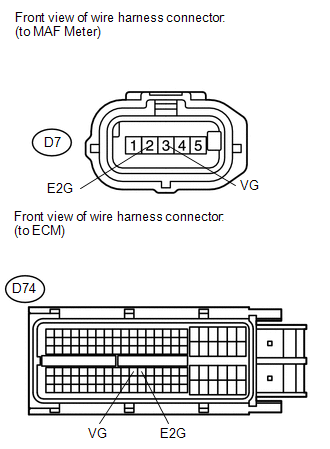 (a) Disconnect the MAF meter connector.
(b) Disconnect the ECM connector. (c) Measure the resistance according to the value(s) in the table below.
Standard Resistance: |
Tester Connection | Condition |
Specified Condition | |
D7-3 (VG) - D74-74 (VG) |
Always | Below 1 Ω | |
D7-2 (E2G) - D74-75 (E2G) |
Always | Below 1 Ω | |
D7-3 (VG) or D74-74 (VG) - Body ground |
Always | 10 kΩ or higher |
| NG |
 | REPAIR OR REPLACE HARNESS OR CONNECTOR |
|
OK |
 | |
| 34. |
REPLACE MASS AIR FLOW METER | (a) Replace the mass air flow meter (See page
 ). ).
HINT:
- If the results of the inspection performed in steps 15 and 22 indicates
no problem, proceed to the next step without replacing the mass air flow
meter assembly.
- Perform "Inspection After Repair" after replacing the mass air flow meter (See page
 ). ).
|
NEXT |
 | |
| 35. |
CHECK WHETHER DTC OUTPUT RECURS | (a) Connect the Techstream to the DLC3.
(b) Turn the ignition switch to ON. (c) Turn the Techstream on.
(d) Clear the DTC (See page  ). ). (e) Turn the ignition switch off and wait for at least 30 seconds.
(f) Turn the ignition switch to ON and turn the Techstream on. (g) Start the engine and warm it up.
(h) Drive the vehicle in accordance with the driving pattern described in the Confirmation Driving Pattern.
(i) Enter the following menus: Powertrain / Engine and ECT / Utility / All Readiness.
(j) Input the DTC: P0300, P0301, P0302, P0303, P0304, P0305, P0306, P0307 or P0308.
(k) Check the DTC judgment result. Result |
Result | Proceed to | |
NORMAL (DTC is not output) |
A | | ABNORMAL
(DTC P0300, P0301, P0302, P0303, P0304, P0305, P0306, P0307 or P0308 is output) |
B |
| A |
 | END |
| B |
 | REPLACE ECM |
(a) Check the fuel lines for leaks or blockage.
HINT: Perform "Inspection After Repair" after replacing the fuel pump (See page
 ). ).
| OK |  |
REPLACE FUEL PUMP |
| NG |
 | REPAIR OR REPLACE FUEL LINE | | 





